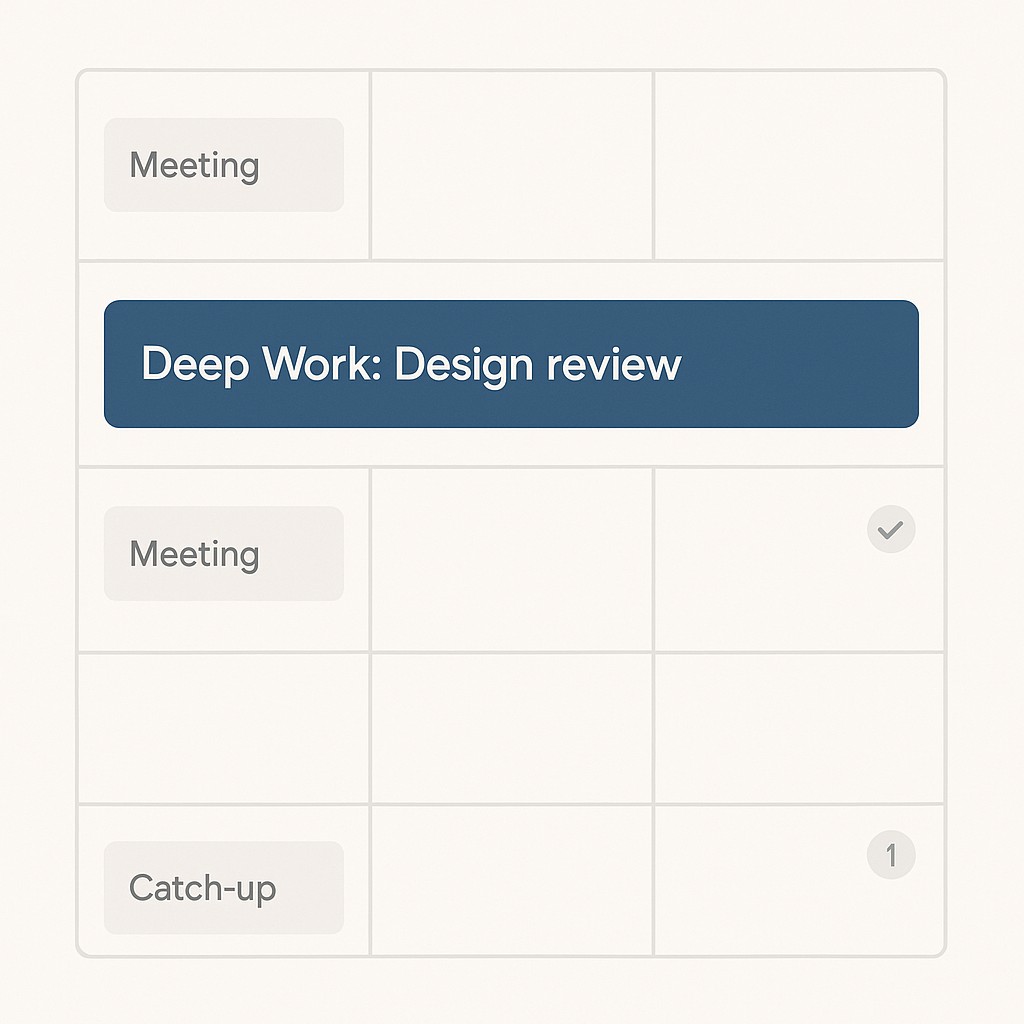Protect Deep Work Time by Treating Focus Like a Meeting
Protect Deep Work Time by Treating Focus Like a Meeting

The Block That Changed Everything
I’ll be honest. Blocking off a chunk of my calendar to protect deep work time used to make me squirm. Even leading an engineering team, I felt that old pressure, like I was breaking some unwritten rule every time I prioritized deep work over quick replies.

Six months ago I wouldn’t have even tried time blocking. It seemed like something managers did, not something like calendar blocking for engineers. The culture was fuzzy around permission, and carving out focus felt risky—almost selfish.
The thing is, when interruptions are the norm, reducing workplace interruptions becomes essential—yet 57% of IT staff spend just 11 minutes on a task before switching to something else. I kept catching myself sprinting from message to message, convinced that clearing notifications meant clear progress. Real talk: the high-impact work—the parts that actually moved the project—kept drifting into “tomorrow” territory.
So, one week, I tried an experiment. I scheduled a single two-hour block, labeled exactly what I’d be working on, and stopped apologizing for it. No sneaking, no hand-wringing. A real appointment, visible, purpose-named.
And those “urgent” pings? Most could wait. A couple genuinely needed me. But the world didn’t stop when I held my boundary. Turns out the rules aren’t as rigid as we think. You really can create space for deep work—without guilt.
How Naming and Scheduling Makes Focus Real—Not Selfish
Treating focused work like any other meeting flips the whole story. Practice time blocking deep work—give it a clear title, put it on your calendar, and be upfront about when you’re available. This signals to others—and honestly to yourself—that the time isn’t indulgent, it’s intentional. When I actually gave my calendar block its own name, something clicked. Labeling dedicated time this way helped 67% of individual contributors and 71% of managers make more progress on key priorities than usual. It’s oddly satisfying to see the block there, as legitimate as a demo review or a one-on-one.
Earlier on, I felt real hesitation about reserving heads-down time. Nobody said “You can’t do that”—but the silence made it worse. When you’re new or if the team vibe is always-on, it’s easy to act as if focus time is a luxury instead of a necessity. I remember thinking any gap in responsiveness would imply I wasn’t pulling my weight. But the reality: permission isn’t written down, and it rarely needs to be. Ambiguity fills the space, and we make up rules that don’t really exist.
Over time, though, I realized that naming the block and communicating its purpose didn’t stir resistance. It actually earned respect. Making deep work explicit reframes it as “this is what doing good work looks like,” not stealing minutes for yourself.
The availability part is usually where the worry lands. I set my status to “focusing” and used it to set focus boundaries, including a note that true emergencies could ping me directly. Early on, I had to define what qualified—site issues, urgent blockers—and told my team exactly where to drop those escalations if needed.
I found naming matters. Purpose-driven labels like “Refactoring Planning,” “Design Review,” or just plain “Focus Time” make boundaries clear. When the block says what you’re working on, it’s obvious this isn’t generic “do not disturb”—it’s significant work happening now.
The final step to normalizing this habit? Share what came out of it. I post a short update in Slack or mention it in standup. “Knocked out spec review in my focus block; ready for feedback.” That’s how you turn heads-down time into visible, valued progress. Show the results and the team starts seeing efforts to protect focus time as a driver, not a drain.
Sometimes, your deliberate defense of focus leads to odd corners. Last month, I mixed up time zones and ended up putting my focus block in the middle of a release window. About halfway through, my Slack lit up. Two people pinged about a test failure; one was asking if I’d seen the new mockups, and a third was just sharing a meme.
I remember wrestling with this fit of guilt in real time—do I drop my block, or do I hold the line? I stuck with it, but I spent the rest of that hour only half-focused, jumping between tabs and feeling like I’d botched the whole experiment. Maybe that was the real lesson: sometimes you mess it up, and it’s awkward, but the block still mostly does its job.
How To Schedule, Defend, and Protect Deep Work Time So Your Focus Block Sticks
Let’s get practical. Here’s the simplest way to try this. Just grab your calendar and give yourself two hours, this week. Don’t overthink it. Scan for the first gap that isn’t swallowed by meetings or deadlines.
Now comes the crucial part. Give your block a name with a purpose—something specific, not vague. “API Refactor Plan,” “Strategy Session,” or “Heads Down on Search Performance.” Set your status to “focusing,” and add a short note for your team: “On deep work block for X, available for urgent site issues or blockers—DM me if needed.” It’s not fancy, but it’s clear. Framing cuts down back-and-forth, lets people know when to really interrupt, and helps stabilize outputs.
Sometimes, you’ll need a script. Honestly, I use it more often than I thought I would. “I’m on a heads-down work block for the next two hours, but DM me if there’s a true emergency.” It makes the boundary real, but doesn’t shut out what matters.
Here’s what I wish I’d heard early: most “urgent” things aren’t. You can batch replies after your block, and rarely does a real emergency spiral before you’ve wrapped up. At first, it feels risky—but once you’ve done this a few times, expecting non-critical pings to wait becomes normal.
If you want to make the habit stick, try the silent working session variation. Invite a teammate to block the same time—no call, no meeting, just a shared calendar event with the task spelled out. You both work independently. Maybe chat stays off or muted, but you get a small boost from knowing it’s a team effort. For some reason, the act of naming that time and having mutual focus legitimizes deep work—and sometimes makes it feel less solitary.
Labeling helps. “Strategy Session,” “Design Review,” even a simple “Focus Time” on your calendar does more than signal you’re busy—it stands up to random drop-ins. I’ve noticed teammates are way less likely to interrupt when they see what the time is actually for, versus just “busy.”
Back in that messy time zone fiasco I mentioned earlier, what saved me was posting a short Slack recap after it wrapped. Day wasn’t ideal, but colleagues saw progress and the block turned out to be more useful than it felt in the moment. Results—not perfection—change how people see that focus window.
Then after your block finishes, do one small thing. Share a note with what you shipped or solved. A single Slack message, a line in standup. It’s quick, but when you do it regularly, it closes the loop and shows that your focus time delivers real, visible value.
Building Confidence: Your Boundaries Won’t Break Everything
Worried about missing a crisis? Don’t be. For my focus blocks, I set a simple rule. If it’s a true emergency—production down, someone truly blocked—my team pings me directly via DM. That’s it. Define what interrupts you. Set the signal. Tell people up front how you protect deep work time. You’re not disappearing, just protecting your best hours.
Let’s talk perception, because this one gets under your skin. Time blocking isn’t selfish. It’s how real work gets done. With meetings eating more than 85% of the day, and 70% of respondents saying meetings keep people from actually getting things done, deep work isn’t selfish—it’s how anything gets built. Nobody questions calendar time for standups or demos. So why treat deep work differently? I used to worry about how my blocks looked—would the team see me as less available, less dedicated? But every time I modeled deliberate focus, it actually encouraged others to try for themselves. If you’re leading, your actions set permission. Reserve it, label it, and be open about why. That reframing helps everyone—especially the folks feeling the same doubts.
My boundaries held, and so did my momentum. I won’t pretend I never get pulled into responding when I shouldn’t. There are still days I cave to the “just this one ping” mindset, and I’m not totally sure that’ll ever change. Maybe that little unfinished part is okay.
Don’t overcommit or promise daily blocks. Forget four two-hour sessions a week for now. Just try one. Find a slot this week, put it on your calendar, and see what happens. If it works, tweak and repeat next week. You’ll build credibility—with yourself and your team—by showing actual outcomes, not just good intentions.
Make Deep Work a Legitimate, Guilt-Free Habit
Let’s circle back. If you treat your focus blocks like any other meeting—give them a name, put them out there, show the results—deep work becomes part of your rhythm, not a heroic one-off. When you make your progress visible and legitimate, you shift from fighting guilt to building momentum. It stops being dramatic every time you protect your attention. It’s just how you move important work forward. Your team sees this too. The more you normalize deliberate focus, the more it compounds—for you and anyone watching.
Here’s something actionable. When you finish a focus block (today, tomorrow, whenever you try this), post a quick update about what moved and what’s next. That tiny habit reinforces your boundary and shows the real value—one block at a time.
After your focus block, spin up a quick status update, spec recap, or Slack note with AI, so you share outcomes fast without breaking your momentum.
Enjoyed this post? For more insights on engineering leadership, mindful productivity, and navigating the modern workday, follow me on LinkedIn to stay inspired and join the conversation.
You can also view and comment on the original post here .
